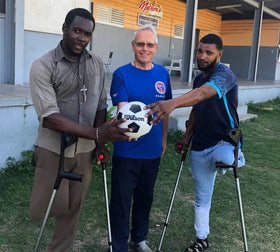Cure Carpal Tunnel Without Surgery
A $3 Bottle of vitamin B may be all it takes
Ten years ago, carpal tunnel syndrome (CTS) was most often seen in factory workers, secretaries, and supermarket cashiers whose jobs required them to repeat the same hand and wrist movements thousands of times a day. Besides experiencing ordinary soreness, CTS patients progressively suffer a weakened grip, stiff finders in the morning, and crippling pain in the hands and wrists. With the widespread use of personal computers, the incidence of carpal tunnel syndrome referring specifically to an injured nerve in the wrist has soared among people in a much wider range of professions.
Today, surgery is considered the primary treatment among conventional physicians, just as it was 10 years ago. Physician John Ellis of Mt. Pleasant, Texas, however, does not agree that surgery is needed. Ellis says that surgery doesn't treat the cause of CTS. The mainstream medical theory is that repetitive movement is the sole cause of CTS. Ellis calls this "ergonomics talk." He says, " There are big dollars tied up in surgery for Carpal tunnel syndrome. For $3, I can cure CTS in better than 90 percent of patients."
Ellis $3 cure is a bottle of Vitamin B6 (pyridoxine) tablets, available at any health food store. Indeed several controlled studies- some conducted by Ellis himself show that severe B6 deficiency is at least a major co-factor in the development of CTS. While repetitive movement clearly exacerbates the condition, CTS may not develop without the B6 deficiency.
Ellis made the connection between B6 deficiency and CTS more than 20 years ago. Women who were either pregnant or taking oral contraceptives were known to have increased requirements for B6 as were diabetics. All three groups also had a higher than average incidence of CTS.
One of Ellis's patients was a 4- year old man with hands crippled by CTS. His diet left a lot to be desired: he skipped breakfast, ate only a sandwich and soft drink for lunch, and for dinner had soup made from vegetables and hamburger. To assess his patient's B6 intake, Ellis measured blood levels of erythrovyte glutamic oxaloacetic transminase (EGOT), an enzyme that reflects B6 activity in the body. When Ellis first tested him, the man's EGOT levels were nearly exhausted, typical of CTS patients.
Ellis started him on 2 mg of B6 daily, which is the U.S. Recommended Dietary Allowance. After two months, the man's EGOT levels increased a little, and he showed "slight clinical improvement." When Ellis increased the dose to 100 mg daily, the patient's EGOT level zoomed, peaking after two months. At the same time, his CTS symptoms receded and finally disappeared.
Ellis then gave the patient an identical looking placebo, without telling him what he was doing. Within days, "the patient strongly complained that pyridoxine was no longer effective and his symptoms returned." After resuming the B6 supplements, his symptoms again disappeared.
Ellis notes, though, that vitamin B6 is not an overnight cure for CTS. Taking the vitamin long enough is as important as taking the right dose. Ellis discovered this when a six week study failed to help patients. " You need 90 days running rooms," he explained to National Health. " It takes four to six weeks to get these enzymes loaded to get them functioning well biochemically, and another four to six weeks for the symptoms to recede, roughly three months.
" For 90 days, you need to take 100 mg after breakfast and 100 mg after dinner, adding up to 200 mg daily. If you're a diabetic age 11 or older, you need a total of 300 mg daily." Ellis says that this regimen has been proven safe for diabetics as well as for pregnant women. None of his patients who have stayed on the B6 for the 90 days have required surgery, but it's possible that in cases where nerve tissue is seriously damaged, surgery would be required.
Many of Ellis's patients have been factory workers, where they repeat the same hand and wrist motion thousands of times a day. Most of his patients continued working while taking B6 supplements, and their conditions improved. It's likely, however, that without the stress from the continued repetitive movement, their healing would have proceeded more quickly.
While the precise biochemical link between B6 and CTS isn't clear, Ellis has a general idea of how it helps. Vitamin B6 is essential for the body's production of 18 of the 20 most important amino acids for 118 known enzymes, "for life itself," Ellis said. A B6 deficiency also reduces the effectiveness of collagen and elastin fibrils, which are needed to cement tissues together. Impaired collagen and elastin synthesis may make tissues more susceptible to injury.
Although Ellis has seen no side effects in people who take high doses of B6, studies have shown that there is a risk of peripheral neuropathy ( a nervous system disorder that, ironically, includes the same tingling, numbness, and weakness characteristics of CTS). Experts that Natural Health consulted considered the risk of peripheral neuropathy to be slight. The studies in question showed that when symptoms of peripheral neuropathy are caused by excessive B6, they go away within a few months of stopping supplemental use.
Also, because B6 is a diuretic, it reduces the edema ( excessive fluid retention) associated with CTS, people may need to add magnesium (100 mg) and potassium (50 mg) supplements while taking B6. These two nutrients are commonly lost while taking a diuretic.
Finally, since all vitamins in the B complex often work hand in hand , and a deficiency in one will many times be accompanied by deficiencies in others, nutritionists generally recommend that people take a 50 mg B-complex supplement if they are taking megadoses of one B vitamin.
Although Ellis has successfully treated CTS patients using only B6, Karl Folkers, Ph.D, a researcher at the University of Texas Institute for Biochemical Research in Austin, believes that at least one other B vitamin may specifically help in the treatment of CTS, vitamin B2 (riboflavin). " People are rarely deficient in only one nutrient," said Folkers, who is a frequent collaborator with Ellis. " Most forms of pyridoxine are inactive. In order to be converted to the active form, they need B2."
In fact, while Folkers found B2 to be helpful in reducing CTS symptoms, a combination of B2 and B6 was most effective. In one case, Folkers gave a 32 year old man 50 mg of B2 for five months. Although the patient's condition improved significantly, he still suffered occasional symptoms. Folkers then added 500 mg of B6 daily to the patient's regimen. After another three months, his CTS symptoms disappeared completely.
Because there is a good chance that people who suffer from CTS are nutritionally deficient, it may be prudent for them to contact a health advisor specializing in nutrition who can help them not only design a supplementation program available in a variety of foods, including organ meats (such as liver), fish, whole grains, dried beans and nuts. It does not appear in very large quantities in many foods, however, and since B6 is lost in cooking and is refined out of many foods during processing, it is not easy to obtain adequate amounts in the diet.
" The problem (CTS) will continue," Ellis says, " as long as people eat over-cooked, over-baked, canned, bottled, packaged foods that are deficient in B6, We need to change how we eat. People need more B6."

